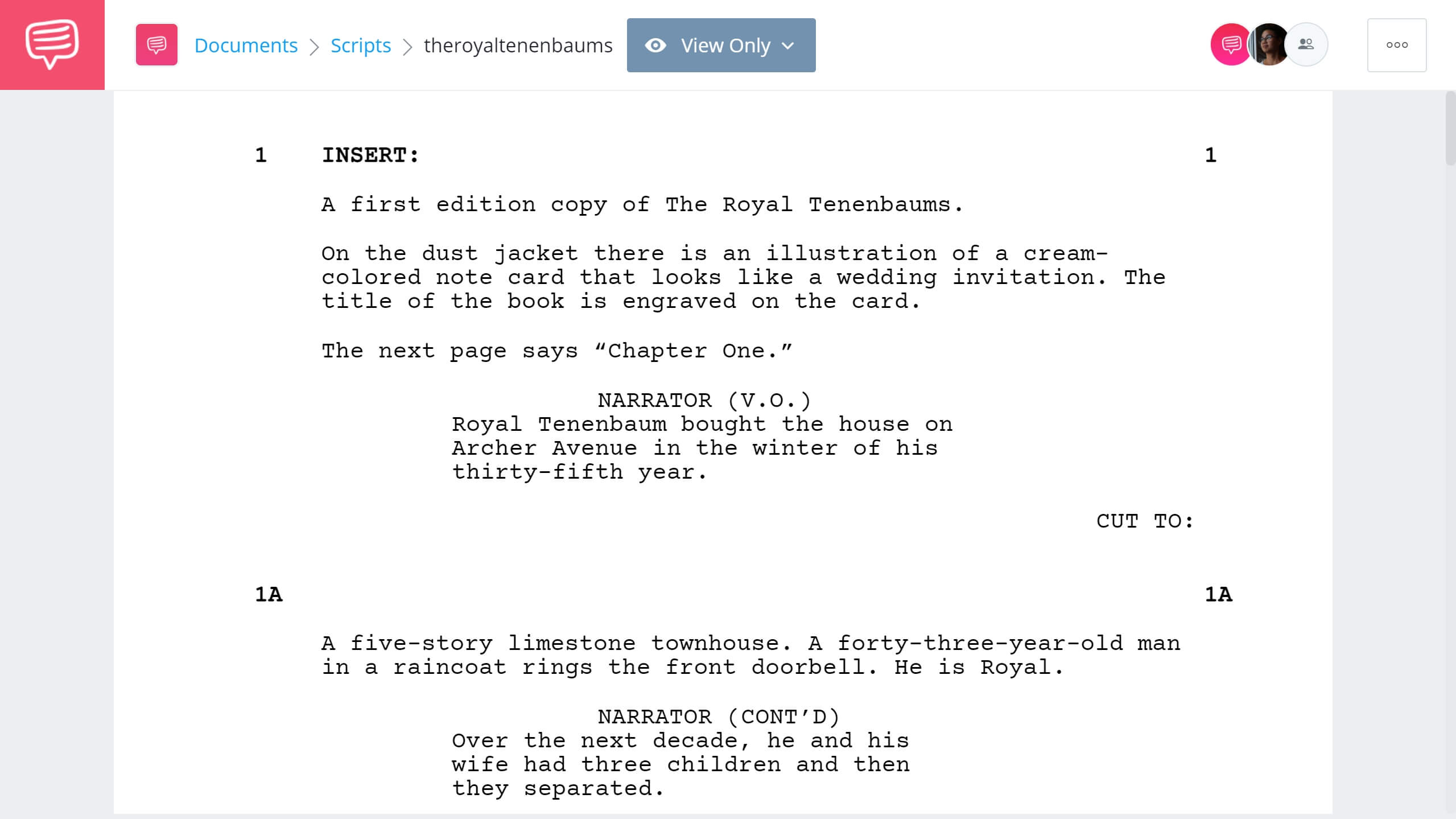

Now - something catching GIANCARLO’S EYE - A SCAR ON THE TINK - TINK - bullet fragments falling into a washed-out Now - GIANCARLO with a flashlight in his teeth - TINK. GIANCARLO playing doctor in a greasy kitchen apron.

Groans - words - snatches of them - all in different Transformed into a makeshift operating room. FISHING BOAT BUNK ROOM - DAWN - TIME CUTS For example, here’s a passage from the script of “The Bourne Identity” by Tony Gilroy, based on the novel by Robert Ludlum: When you try to force them into a vertical pattern, you actually break the flow and make it more difficult to read down the page. So the next time you think about adding a ten-line paragraph to explain that this is a comfortable, well-furnished craftsman-style house that nestles on the edge of town surrounded by sycamore trees with a luxury car parked on the drive outside… think again. The reader’s mind fils in the blanks. In fact “Alien” uses only two words to describe a spaceship’s engine room. The writers were adept at using minimal words to convey a setting. There is also far less detail than you think in these lines. This is a nice, flowing style that leads your eye down the page. It sits alone with no neighbors in sight.
#Script slugline in a car full#
CASEY’S HOUSE – NIGHT – ESTABLISHINGĪ big country home with a huge sprawling lawn full of big oak I guess I dialed the wrong number.Ĭasey stands in front of a sliding glass door. The CAMERA PULLS BACK to revealĬasey in a living room, alone. A friendly faceĬLICK! She hangs up the phone. Here’s a slightly more modern example, from a draft of “Scream” written by Kevin Williamson:Ī hand reaches for it, bringing the receiver up to the face ofĬASEY BECKER, a young girl, no more than sixteen. Also, this tends to use up a lot of pages. Do that enough times and the reader will actually finish your screenplay.īut you don’t need to be so drastic. Pretty obvious why it’s called the “vertical” style, right? The aim is to make the reader’s eye naturally flow down the page thus causing him or her to TURN OVER and start reading the next page. Here is a sample taken from the revised script by Walther Hill and David Giler, based on the original script by Dan O’Bannon and Ronald Shusett: The “vertical” style was perhaps most famously used in “Alien”. The main aim of all stylistic devices in a screenplay is… to get the reader to read yor script. Style can make or break a script, or turn a great story into a terrible script.
#Script slugline in a car how to#
It’s a more efficient way to navigate the script, and will lead to an easier read.Today, here are some tips on how to do the above – write action lines like the ones you see in Hollywood screenplays. More cards ebb and flow, Christy wins, loses, and loses.Ĭhristy wipes away sweat, coming down to earth.ĭitch sluglines for INTERCUT. The dealer shuffling a second time, a third, without a word to Christy. Lucky Nick downing stomach tablets, feeling ill.įrank downing antacid tablets, feeling the same. Wes and Susie, digging in for the long haul, watching in an overhead mirror. The new dealer spooks Christy, who buries the cut card.Ī huge crowd pushes in, casino supervisors and the crossroaders surround Christy and the dealer, ready to play blackjack at ,000 a hand. Pale features, coldly efficient and mechanical, offering Christy the cut. The dealer finishes the shuffle, and is abruptly tapped out. Susie takes off her wig, all pretenses gone, Wes and Sculley likewise undisguised, likewise in shock. Lucky Nick, sweating as he looks at Christy, mumbles various obscenities.įrank taking his frustration out on a slot machine, pulls too hard, hurting himself. Christy doesn’t watch, hungrily chewing a pastrami sandwich. Speaking of Phone Booth, here’s what a one-sided phone conversation looks like. The recent use of texting in The Departed was well done, but extensive use of telephones is tricky to pull off visually. One more note on phone conversations: With all respect to Phone Booth, holding on one-side of a phone conversation for very long is static, non-visual stuff. Remember, the reader is reading a movie, not a script. To write in slugline after slugline takes the reader out of the flow. This lets the director decide which end of the phone conversation we’re seeing. Set up both locations, intercut, and roll the dialogue. You’re going to watch Family Guy while this country is burning? While we as a nation are at the shithouse door? Can I come over? Dominos, maybe some Family Guy I TIVO’ed. John, even for you, that’s a pretty dumb idea. How do we spin this, John? How about getting the governors to not take stimulus money? They’re calling us obstructionists, nay sayers!
#Script slugline in a car tv#
McCain on the phone, watching the same TV broadcast. Boehner looks on as a TV plays his news conference from earlier in the day.


 0 kommentar(er)
0 kommentar(er)
